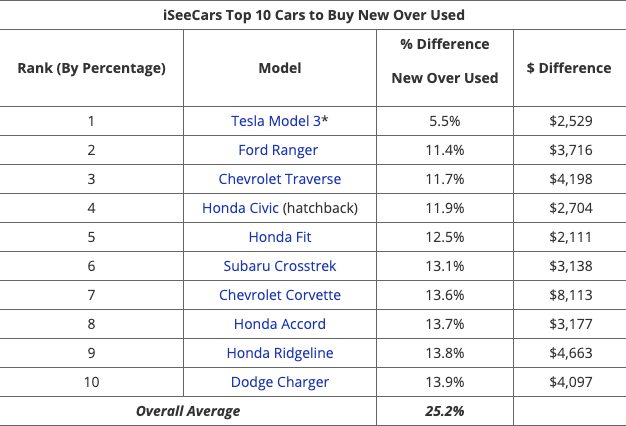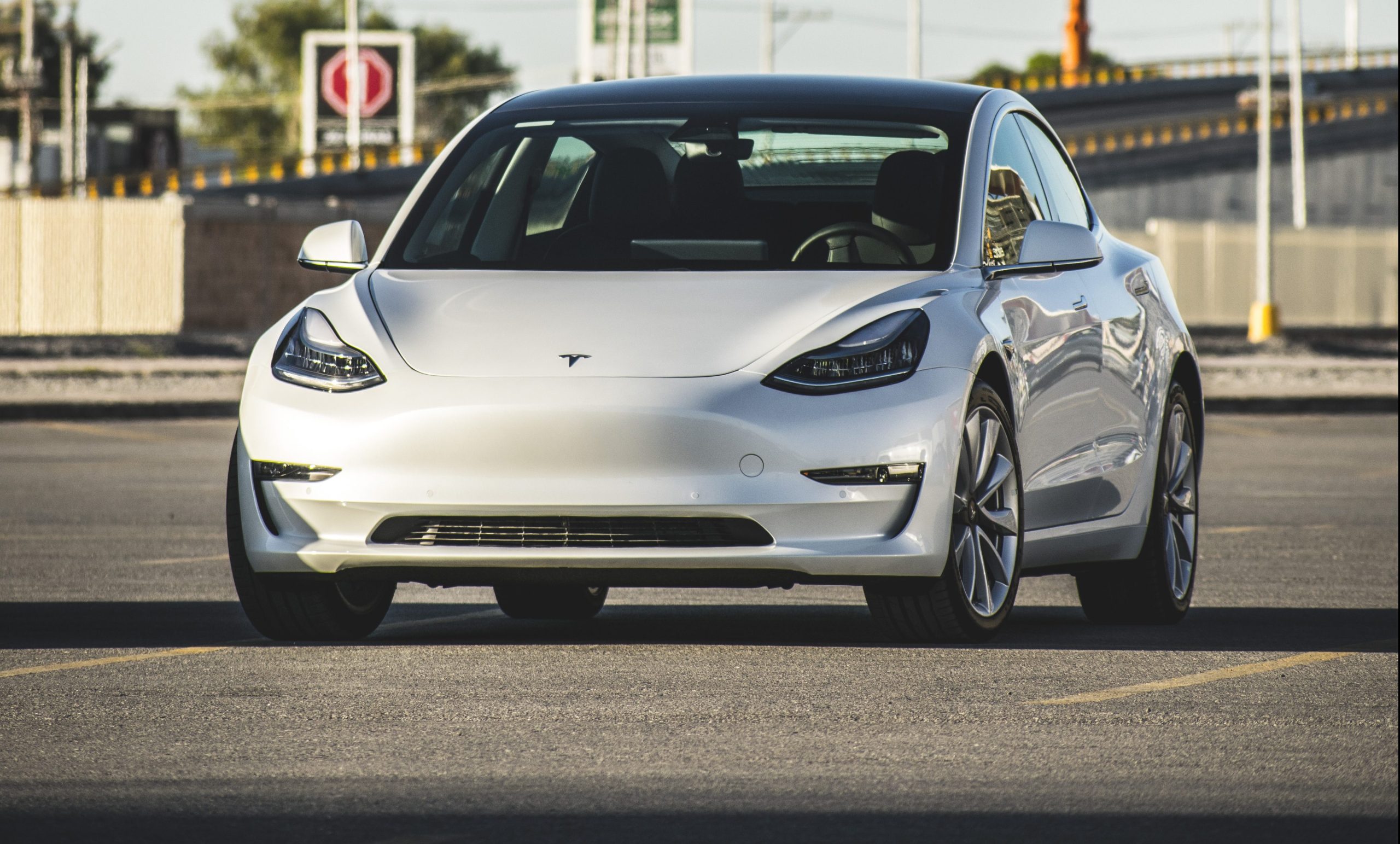The Tesla Model 3 was ranked number 1 on a new study that analyzed the value retention of vehicles on the market. The Model 3 only showed a depreciation of 5.5% compared to the price of a new unit. That’s half the depreciation compared of the second-ranked vehicle on the study’s Top 10 list, the incredibly popular Ford Ranger pickup truck.
The study from iSeeCars.com noted the difference in value between two Model 3s manufactured a year apart was only $2,529. That’s just roughly the price of a few options from Tesla’s online configurator, like paint and white seats. With prices this close, there will likely be very little incentive for prospective EV buyers to opt for a second-hand Model 3.
One of the key motivations for buyers of second-hand cars is the supposed low price of the used vehicles themselves. Cars are notorious for losing a significant part of their value as soon as they are driven off the lot, and generally, electric vehicles see an even steeper depreciation. But for Tesla buyers, the high value retention of the company’s vehicles means that most of the time, it becomes far more practical to acquire a brand new Model 3 from the electric car maker.

This is something that was highlighted by iSeeCars CEO Phong Ly in a statement. “Instead of buying a car that’s already been driven for one year, consumers can buy the new version of select vehicles with a purchase price of just a few thousand dollars more to avoid the uncertainties that come with purchasing a used vehicle,” he said.
The iSeeCars CEO has valid points. There are notable uncertainties when one purchases an electric car. A second-hand car whose previous owner was careless may be prone to more issues compared to a new vehicle, for example. Apart from this, purchasing new cars offer a lot of benefits to consumers, since buyers will have full control on what their cars will be equipped with, from its interior to software-based features such as the Full Self-Driving suite.
The benefits of new Teslas extend beyond the cars’ buyers as well. The electric car maker benefits from operating a fleet of vehicles that are comprised of mostly new cars. Tesla is known for incrementally improving its vehicles to an almost obsessive degree. This means that when it comes to Teslas, it is always in the best interest of consumers to purchase the latest cars to make sure that they are getting the best tech and features available.
Does this mean that there is no place for Teslas in the second hand market? Definitely not. Second-hand Teslas will likely play a valuable role in the years to come, considering that the company is still expanding its presence across the globe and is yet to enter some large markets like India. Tesla is on a path towards a future where it could eventually produce millions of cars every year. Once this happens, Teslas will likely become ubiquitous enough that the second-hand market for the company’s electric cars will be friendlier to buyers.
Second-hand Teslas can also play a huge role in the company’s Robotaxi Network, which will utilize vehicles for ride-hailing services. For owners who wish to operate several Robotaxis, even the small savings offered by pre-owned vehicles will go a long way to ensure that their return of investment is quick. For now, though, and as long as Tesla is demand constrained, buyers can expect the Model 3 to resiliently retain its value years after it is purchased.
If there is anything shown in iSeeCars’ recent study, it is that Tesla is breaking stereotypes once more. A separate study from the firm showed that electric vehicles depreciate by 56.6% in three years, significantly more than 38.2% average depreciation across most petrol vehicles. Tesla has bucked this trend, however, with its entire lineup of vehicles like the Model 3, Model S, and Model X.

Elon Musk
Elon Musk’s X will start using a Tesla-like software update strategy
The initiative seems designed to accelerate updates to the social media platform, while maintaining maximum transparency.

Elon Musk’s social media platform X will adopt a Tesla-esque approach to software updates for its algorithm.
The initiative seems designed to accelerate updates to the social media platform, while maintaining maximum transparency.
X’s updates to its updates
As per Musk in a post on X, the social media company will be making a new algorithm to determine what organic and advertising posts are recommended to users. These updates would then be repeated every four weeks.
“We will make the new 𝕏 algorithm, including all code used to determine what organic and advertising posts are recommended to users, open source in 7 days. This will be repeated every 4 weeks, with comprehensive developer notes, to help you understand what changed,” Musk wrote in his post.
The initiative somewhat mirrors Tesla’s over-the-air update model, where vehicle software is regularly refined and pushed to users with detailed release notes. This should allow users to better understand the details of X’s every update and foster a healthy feedback loop for the social media platform.
xAI and X
X, formerly Twitter, has been acquired by Elon Musk’s artificial intelligence startup, xAI last year. Since then, xAI has seen a rapid rise in valuation. Following the company’s the company’s upsized $20 billion Series E funding round, estimates now suggest that xAI is worth tens about $230 to $235 billion. That’s several times larger than Tesla when Elon Musk received his controversial 2018 CEO Performance Award.
As per xAI, the Series E funding round attracted a diverse group of investors, including Valor Equity Partners, Stepstone Group, Fidelity Management & Research Company, Qatar Investment Authority, MGX, and Baron Capital Group, among others. Strategic partners NVIDIA and Cisco Investments also continued support for building the world’s largest GPU clusters.
News
Tesla FSD Supervised wins MotorTrend’s Best Driver Assistance Award
The decision marks a notable reversal for the publication from prior years, with judges citing major real-world improvements that pushed Tesla’s latest FSD software ahead of every competing ADAS system.

Tesla’s Full Self-Driving (Supervised) system has been named the best driver-assistance technology on the market, earning top honors at the 2026 MotorTrend Best Tech Awards.
The decision marks a notable reversal for the publication from prior years, with judges citing major real-world improvements that pushed Tesla’s latest FSD software ahead of every competing ADAS system. And it wasn’t even close.
MotorTrend reverses course
MotorTrend awarded Tesla FSD (Supervised) its 2026 Best Tech Driver Assistance title after extensive testing of the latest v14 software. The publication acknowledged that it had previously criticized earlier versions of FSD for erratic behavior and near-miss incidents, ultimately favoring rivals such as GM’s Super Cruise in earlier evaluations.
According to MotorTrend, the newest iteration of FSD resolved many of those shortcomings. Testers said v14 showed far smoother behavior in complex urban scenarios, including unprotected left turns, traffic circles, emergency vehicles, and dense city streets. While the system still requires constant driver supervision, judges concluded that no other advanced driver-assistance system currently matches its breadth of capability.
Unlike rival systems that rely on combinations of cameras, radar, lidar, and mapped highways, Tesla’s FSD operates using a camera-only approach and is capable of driving on city streets, rural roads, and freeways. MotorTrend stated that pure utility, the ability to handle nearly all road types, ultimately separated FSD from competitors like Ford BlueCruise, GM Super Cruise, and BMW’s Highway Assistant.
High cost and high capability
MotorTrend also addressed FSD’s pricing, which remains significantly higher than rival systems. Tesla currently charges $8,000 for a one-time purchase or $99 per month for a subscription, compared with far lower upfront and subscription costs from other automakers. The publication noted that the premium is justified given FSD’s unmatched scope and continuous software evolution.
Safety remained a central focus of the evaluation. While testers reported collision-free operation over thousands of miles, they noted ongoing concerns around FSD’s configurable driving modes, including options that allow aggressive driving and speeds beyond posted limits. MotorTrend emphasized that, like all Level 2 systems, FSD still depends on a fully attentive human driver at all times.
Despite those caveats, the publication concluded that Tesla’s rapid software progress fundamentally reshaped the competitive landscape. For drivers seeking the most capable hands-on driver-assistance system available today, MotorTrend concluded Tesla FSD (Supervised) now stands alone at the top.
News
Elon Musk’s Grokipedia surges to 5.6M articles, almost 79% of English Wikipedia
The explosive growth marks a major milestone for the AI-powered online encyclopedia, which was launched by Elon Musk’s xAI just months ago.

Elon Musk’s Grokipedia has grown to an impressive 5,615,201 articles as of today, closing in on 79% of the English Wikipedia’s current total of 7,119,376 articles.
The explosive growth marks a major milestone for the AI-powered online encyclopedia, which was launched by Elon Musk’s xAI just months ago. Needless to say, it would only be a matter of time before Grokipedia exceeds English Wikipedia in sheer volume.
Grokipedia’s rapid growth
xAI’s vision for Grokipedia emphasizes neutrality, while Grok’s reasoning capabilities allow for fast drafting and fact-checking. When Elon Musk announced the initiative in late September 2025, he noted that Grokipedia would be an improvement to Wikipedia because it would be designed to avoid bias.
At the time, Musk noted that Grokipedia “is a necessary step towards the xAI goal of understanding the Universe.”
Grokipedia was launched in late October, and while xAI was careful to list it only as Version 0.1 at the time, the online encyclopedia immediately earned praise. Wikipedia co-founder Larry Sanger highlighted the project’s innovative approach, noting how it leverages AI to fill knowledge gaps and enable rapid updates. Netizens also observed how Grokipedia tends to present articles in a more objective manner compared to Wikipedia, which is edited by humans.
Elon Musk’s ambitious plans
With 5,615,201 total articles, Grokipedia has now grown to almost 79% of English Wikipedia’s article base. This is incredibly quick, though Grokipedia remains text-only for now. xAI, for its part, has now updated the online encyclopedia’s iteration to v0.2.
Elon Musk has shared bold ideas for Grokipedia, including sending a record of the entire knowledge base to space as part of xAI’s mission to preserve and expand human understanding. At some point, Musk stated that Grokipedia will be renamed to Encyclopedia Galactica, and it will be sent to the cosmos.
“When Grokipedia is good enough (long way to go), we will change the name to Encyclopedia Galactica. It will be an open source distillation of all knowledge, including audio, images and video. Join xAI to help build the sci-fi version of the Library of Alexandria!” Musk wrote, adding in a later post that “Copies will be etched in stone and sent to the Moon, Mars and beyond. This time, it will not be lost.”










